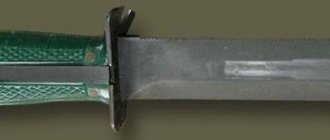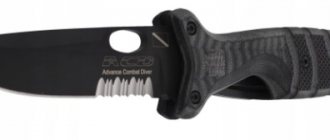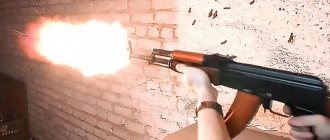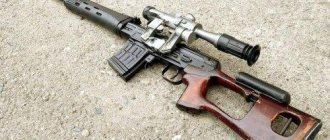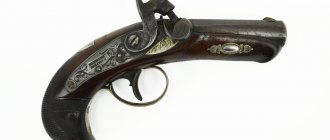Experimental bayonet for the AK-74 assault rifle
An experimental bayonet for the AK-74 assault rifle was created to replace the 6x4 bayonet in 1986. The bayonet was produced in a small batch at the Izhevsk plant for military testing in 1986-1987. A small number of bayonet knives were transferred to a limited contingent of Soviet troops in Afghanistan.
The experimental bayonet for the AK-74 assault rifle had a blade with a symmetrical spear-shaped combat end and double-sided sharpening. A feature of the blade was its relatively large thickness, which is why there was a pronounced bevel in the area of the cutting edge, which led to a thinning of the blade. The same bevel was present on the other edge, on the side of the saw teeth. Subsequently, a similar blade was used on the serial 6X5 bayonet.
The sheath for the bayonet is plastic and has several metal inserts. There are stiffening ribs on the side surface of the sheath. At the top there is an axis for the suspension system. The pendant is made of leather.
The lower part of the scabbard is made of two halves with a gap between them. At one end of the scabbard there is a recess, near which there are two metal blades. To use a bayonet-knife as a wire cutter, the blade of the bayonet had to be placed in the slot of the sheath so that the combat end came out from the side of the recess with the cutting elements. By changing the angle between the bayonet and the sheath, you can move the cutting edges apart and close to cut wire.
The new design of the wire cutters gave the “experimental” bayonet some advantages over previous models. In particular, the absence of a hole made the blade slightly stronger, and the production of the scabbard was simplified by using a minimum of connections between parts. At the same time, the new bayonet retained all the basic functions of the existing weapon. It could be used in bayonet fighting, and also serve as a knife, saw or wire cutter.
The use of new bayonets in the troops made it possible to determine all their strengths and weaknesses. After the mastery of such weapons by individual army units, a new stage in the development of a promising bayonet for the AK-74 assault rifle began. Judging by subsequent events, the military was satisfied with the new design of the blade and handle. At the same time, the new scabbard was not approved.
The military preferred to receive blades with holes and sheaths with proven and proven open mechanisms, equipped with a protruding axis for the bayonet. For some reason, the “built-in” version of the wire cutters was not further developed. Probably, the low degree of unification of the old and new models had an effect.
Based on the results of tests and trial operation in the army, it was decided to change the design of the weapon, using existing developments, which resulted in the appearance of the 6X5 bayonet in the form we are familiar with, which was adopted for service in 1989.
Technical characteristics of an experimental bayonet for the AK-74 assault rifle:
- Total length of the bayonet in sheath, mm: 343;
- Bayonet length, mm: 290;
- Blade length, mm: 160;
- Blade width, mm: 29;
- Inner diameter of the ring in the crosspiece, mm: 17.5
Initiation
According to the generally accepted, if you like, classical definition, a combat knife is a type of bladed weapon specially designed to destroy enemy personnel. Combat knives can be called knives that are or were in service with the armies and security forces of the world.
combat knife designs
Read on topic: Which knives are not edged weapons: edged weapons in civilian life
History of the development of edged weapons in the USSR
It is known that the Red Army soldiers were armed with Mosin rifles, the design of which did not include a bayonet at all. Later, on their basis, a carbine was created, which was equipped with a tetrahedral bayonet of a removable type designed by Komarnitsky-Kabakov. It was called “bayonet 1891-1930”. The wounds received from him in battle did not heal for a long time and were very painful.
Later, in 1936, the Red Army received the ABC-36 (Simonov rifle), which was equipped with a cleaver knife. After 2 years, the SVT-38 ─ Tokarev’s famous self-loading weapon was adopted. The infantry immediately liked it, and already in 1940 the SVT-40 was released. The steel of the bayonet for this rifle was blued and very durable.
View gallery
The blade was 240 mm in length and 25 mm in width. Thanks to the presence of a ring, the bayonet was attached to the muzzle of the gun.
Considering the bayonet-knives of the Second World War, it is necessary to recall the self-loading bayonet designed by Rakov and Bulkin, the development of which took place in 1940. The blade for this weapon was particularly strong, but the rifle was not accepted for service, so only a few experimental samples remained.
There was also an ersatz bayonet, or, as it was also called, a “siege” bayonet, which was produced in Leningrad during the siege. It was used in conjunction with the Mosin rifle and was attached similarly to the Komarnitsky blade.
Product 6x2 in practice
View gallery
The AK-47 bayonet (photo above) has proven itself to be a reliable and extremely convenient weapon for hand-to-hand combat. The knife incorporates the best elements of Soviet combat knives. It fits comfortably in the hand, and the length of the blade of this product was not chosen by chance - the knife balances perfectly when working with it.
Interestingly, the blade steel of this model is much softer than later modifications. In this regard, the AK-47 USSR bayonet does not break during knife fighting, and also withstands strong blows and falls on a hard surface. Initially, it was not intended that the 47th bayonet model would be used for biting wire or cutting metal, so there are no special design solutions in it. But, being both on the machine gun and in the hand of a fighter, it hits the enemy equally well.
The Last of the Mohicans
The army bayonet-knife developed in 1989 was the last in this family. “Product 6×5” was used as a melee weapon for close combat in the AK-74 models of all modifications, the AK-100 and the Nikonov system assault rifle (made in 1994). Do not forget that more modern editions of the SVD were also equipped with the “five”. If you compare the AK-47 bayonet and the “6×5 product”, you can see what modifications it has undergone over many years.
View gallery
First of all, the latest model of the knife differs from previous versions in the sharper shape of the blade, which has a matte finish. The handle of the product has undergone serious modifications.
Now the AKM bayonet knife has become much more comfortable to hold in the hand due to the presence of transverse thickenings on the handle. In addition, the possibility of breaking the plastic part on the sheath and handle was completely eliminated, since they were made of heavy-duty glass-filled polyamide. The length of the product is 260 mm, the blade is 160 mm, and its width is 29 mm. The AK-47 bayonet, as well as all subsequent models, has a characteristic feature, which is that the diameter of the ring on the knife has not changed and is 17.7 mm on all modifications.
About the famous “NKVD knife”
Ordinary Soviet citizens were prohibited from carrying knives. However, this did not apply to party workers and NKVD employees, who in 1935 received Finnish knives produced by Vachin craftsmen as special means for self-defense. The production of this bladed weapon was based on one of the models of Swedish knives from the Holmberg company.
“Holmberg Finns” were banned by the state for use by the population. There are fullers on both sides of the knife, and a guard in front of the handle. The handle of the product was carbolite. It was believed that this knife was very convenient when working in close combat and when holding it with various grips. The “NKVD Knife” served as the prototype of the edged weapon of Soviet soldiers in early 1940.
About later knife models
The AK-47 bayonet had a steel sheath, as well as a canvas strap, thanks to which the weapon was hung on a uniform belt. The use of a sheath as an auxiliary element for performing a number of jobs has significantly increased the capabilities of edged weapons. The additional functionality of the bayonet greatly facilitated and accelerated the performance of combat missions by army units.
View gallery
After the “troika”, the “6×4 product” model appeared. Actually, it was an AKM bayonet, and a little later it began to be used for the AK-74. At the same time, it was somewhat different from the previous version in that the shape of the handle was changed, and the sheath began to be made of impact-resistant plastic. In addition, a special stop was designed under the barrel of the machine gun, to which the bayonet-knife was attached. Melee weapons were now single-edged, with a somewhat shortened blade with a strongly pointed end.
The presence of a file on the blade allows you to easily cut steel rods. The scabbard also has a special oval-shaped pin and a figured cutout. Thanks to this, the bayonet can act as scissors and cut through steel wire. The total length of the “6×4 product” was 10 mm shorter than the previous model. Modifications of knives produced in 1959 were also used on SVD.
Bayonet for the KA-BAR model
The weapons company LaserLite, familiar to many with its models of additional accessories for reliable firearms, demonstrated a new development - a bayonet for a pistol design. The production of the blade belongs to KA-BAR, a large-scale manufacturer of knives for combat and special purposes.
Model features:
- The bayonet is placed on different types of pistols (medium-sized, large);
- the fastener uses a Picatinny rail;
- The bayonet is removed by simply pressing a pair of buttons along the edges of the fasteners;
- The blade is distinguished by a very sharp sharpening and the presence of black Teflon processing.
According to information. Typically the retail price is just above $40.
Laserlyte developments
During the times of single-shot pistols, weapons equipped with a folding bayonet became widespread. Each subsequent loading of the “innovative” pistol took a lot of time, so the blade on the design ensured that the shooter was at least somewhat armed after firing. The release and priority of revolvers and multi-shot pistols led to the disappearance of such products. However, even today, although very rarely, you can see knives up to the short-barreled weapons familiar to the past era.
, which focuses exclusively on the production of laser designators with the assistance of the Ka-Bar corporation, which produces knives, a revolving bayonet (with the possibility of removal) of the NAA-PB version was designed and successfully manufactured. The device has a dagger-type blade made of high-quality 3CR13 steel. The length of the tip is 4.5 cm. Along the axis of the drums, the bayonet is held in place by a special clamp made of aircraft-grade aluminum. The set includes a plastic sheath.
Next, the company created a whole line of pistol bayonet designs. Various variations of the models are distinguished by the configuration, color of the handle, and the protective layer of the blade. The bayonets can be attached to pistols equipped with a special Picatinny rail for mounting laser pointers and tactical flashlights.
The release includes the following models:
- tactical unit "MINITAC-TOOL" (modification PB4) - length measurement 146 mm and blade length - 64 mm;
- "ZombieKiller Edition" (item number PB-3ZK);
- the “PB Serrated” design (marked PB-3), like the previous “Zombie” model, has a total length of the device of −14.6 cm, and a blade length of 7 cm. Weight - 74 g. Has a plastic sheath.
Similar models are produced by CZ, a Czech corporation Česká Zbrojovka. Its model, called "CZ TBB" is a laser target designator unit articulated with the blade. The level of practicality of such solutions is questionable. And adding a bayonet to the pistol design affects the balancing and accuracy of shots.

